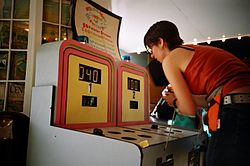Whac-A-Mole: Difference between revisions
No edit summary |
Remove goofy redirect |
||
| Line 1: | Line 1: | ||
{{ |
{{for|the ''House'' episode|Whac-A-Mole (House)}} |
||
{{Refimprove|date=November 2009}} |
{{Refimprove|date=November 2009}} |
||
{{Infobox Game |
{{Infobox Game |
||
Revision as of 13:01, 11 September 2012
This article needs additional citations for verification. (November 2009) |
 A woman playing Whac-A-Mole | |
| Manufacturers | Creative Engineering, Inc. |
|---|---|
| Designers | Aaron Fechter |
| Years active | 1976-present |
Whac-A-Mole is an arcade redemption game. A typical Whac-A-Mole machine consists of a large, waist-level cabinet with five holes in its top and a large, soft, black mallet. Each hole contains a single plastic mole and the machinery necessary to move it up and down. Once the game starts, the moles will begin to pop up from their holes at random. The object of the game is to force the individual moles back into their holes by hitting them directly on the head with the mallet, thereby adding to the player's score. The quicker this is done the higher the final score will be.
Origins
The popular carnival game was invented in 1976 by Aaron Fechter of Creative Engineering, Inc.[1]
Gameplay
The cabinet has a three-digit readout of the current player's score and, on later models, a best score of the day readout. The mallet is usually attached to the game by a rope in order to prevent patrons from walking away with it.
Current versions of the Whac-A-Mole include three displays for Bonus Score, High Score as well as current game score. Home versions as distributed by Bob's Space Racers, include one display to show the current score.
If the player does not strike a mole within a certain time or with enough force, it will eventually sink back into its hole with no score. Although gameplay starts out slow enough for most people to hit all of the moles that rise, it gradually increases in speed, with each mole spending less time above the hole and with more moles outside of their holes at the same time. After a designated time limit, the game ends, regardless of the skill of the player. The final score is based upon the number of moles that the player struck.
In addition to the single-player game described above, there is a multi-player game, most often found at amusement parks. In this version, there is a large bank of individual Whac-A-Mole games linked together, and the goal is to be the first player to reach a designated score, rather than hit the most moles within a certain time. In most versions, striking a mole is worth ten points, and the winner is the first player to reach a score of 150 (i.e. 15 moles). The winner receives a prize, typically a small stuffed animal, which can be traded up for a larger stuffed animal should the player win again.
Game play options have become more adjustable allowing the operator and or owner to selectively alter the high score, hits points, rate of progressive speed as well as the game time.
Variations

The Whac-A-Mole game trademark is owned by Bob's Space Racers.[2] Machines with similar gameplay are sold under other names. Whac-A-Mole has also been the basis for a number of internet games and mobile games that are similar in gameplay and strategy.
Engineer Tim Hunkin built and installed a "Whack a Banker" machine at Southwold Pier in England[3] made from parts of a previous "Whack a Warden" machine.[4]
Colloquial usage
The connotation of "Whac-a-mole" — or "Whack-a-mole" — in colloquial usage is that of a repetitious and futile task: each time an adversary is "whacked", or kicked off a service, he only pops up again somewhere else.[5][6]
- The term has been used in the computer and networking industry to describe the phenomenon of fending off recurring spammers, vandals or miscreants.
- The "Whac-a-mole" comparison has been used in the military to refer to ostensibly inferior opposing troops who keep re-appearing.[7][8]
- This comparison was made by Andrew Krepinevich[9] in reference to General William Westmoreland's obsession with killing Viet Cong as the mainstay of the American military's effort in the VietNam War.
- This use has also been common in the Iraq War in reference to the difficulty of defeating the Iraqi insurgency.[10]
- Nuclear scientist Edwin Lyman compared the multiple simultaneous crises at Fukushima I to a game of "whack-a-mole" [11]
References
- ^ How to grow your brain, The Globe and Mail
- ^ Trademark Electronic Search System (TESS), United States Patent and Trademark Office
- ^ "Bankers 'whacked' in arcade game". BBC News. 2009-12-13. Retrieved 2010-12-27.
- ^ "whack a banker details". Timhunkin.com. Retrieved 2010-12-27.
- ^ Spambot Beware - Glossary of Spam Related Terms
- ^ "What is whack-a-mole? - Definition from Whatis.com". Searchsecurity.techtarget.com. 2002-07-22. Retrieved 2010-12-27.
- ^ Eleanor Clift, et al. "Refusing To Lose." Newsweek 150.4 (2007): 22-30. Academic Search Premier. Web. 7 Dec. 2011.
- ^ Rosenbach, Eric, and Aki Peritz. "The New Find-Fix-Finish Doctrine." JFQ: Joint Force Quarterly 61 (2011): 94-101. Academic Search Premier. Web. 7 Dec. 2011.
- ^ The Army and Vietnam (1986)
- ^ From The Frontlines
- ^ http://www.ucsusa.org/assets/documents/nuclear_power/lyman-testimony-06-07-2011.pdf Testimony before the U.S. Senate Committee on Energy and Natural Resources on Tuesday, June 7, 2011
External links
- Official website of Creative Engineering Inc. maintained by creator Aaron Fechter
- Official Whac-a-Mole website maintained by Bob's Space Racers, Inc.
- Bob's Space Racers - The original manufactures and current trademark holder of Whac-A-Mole
- Whac-A-Mole Flash Game - Bob's Space Racer's Flash version of Whac-A-Mole
- Whac-A-Mole at the Killer List of Videogames
- Museum of Hoaxes article refuting the etymological link claimed between Whac-A-Mole and "guacamole"
- Nintendo Wii version
- Version Windows Phone 7 (Mole Hit)
